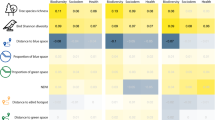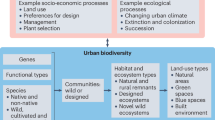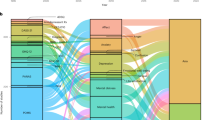Abstract
Nature experiences in biodiversity-rich recreational areas (recreation-permitted protected areas, Key Biodiversity Areas and intact forest landscapes) can provide an extra benefit to mental health compared to managed urban green spaces. However, to what extent urban residents have access to these experiences globally and their cost-effectiveness as mental health treatments remain unclear. Assessing 9,034 cities globally, we find that over 96% of cities have biodiversity-rich recreational areas within two hours, with the affordability of experiences and visiting rates being highest in Europe, Oceania and North America. The extra benefits of experiences in biodiversity-rich recreational areas near cities reduces 137,299 (90% uncertainty range: 10,368–598,509) disability-adjusted life years of depression and anxiety and appears as a cost-effective public health intervention in developed settings in Europe, North America and South America. Lowering traveling costs by establishing new highly biodiverse recreation-permitted protected areas near cities would be a nature-based mental health intervention with potential to benefit biodiversity and urban residents’ health.
This is a preview of subscription content, access via your institution
Access options
Subscribe to this journal
Receive 12 digital issues and online access to articles
$119.00 per year
only $9.92 per issue
Buy this article
- Purchase on SpringerLink
- Instant access to full article PDF
Prices may be subject to local taxes which are calculated during checkout




Similar content being viewed by others
Data availability
The data used in this study were collected from the following sources: global urban boundaries were from the GHS Urban Centre Database of European Commission (https://doi.org/10.2905/4606D58A-DC08-463C-86A9-D49EF461C47F); protected areas datasets were from the World Database on Protected Areas (WDPA) (https://www.protectedplanet.net/en), Resource and Environment Science Data Center (https://www.resdc.cn/data.aspx?DATAID=272) and OpenStreetMap (Geofabrik Download Server); Key Biodiversity Areas boundaries dataset was from The World Database of Key Biodiversity Areas (https://www.keybiodiversityareas.org/); Intact Forest Landscapes dataset was from Intact Forest Landscapes website (Intact Forest Landscapes); the population dataset was from WorldPop (https://doi.org/10.5258/SOTON/WP00647); the global friction surface was from work published by Weiss et al.39 (https://doi.org/10.1038/nature25181); the national minimum monthly wage data were from the statutory nominal gross monthly minimum wage statistics in the ILOSTAT database (https://rshiny.ilo.org/dataexplorer75/?lang=en); the GNI per capita, GDP per capita, exchange rates and historical inflation rates were from the World Bank (World Development Indicators|Data Catalog); the purchase prices of cars were from Numbeo (https://www.numbeo.com/cost-of-living); the gasoline prices were from globalPetrolPrices.com (https://www.globalpetrolprices.com/gasoline_prices/); the train travel prices were from FleetLogging (https://fleetlogging.com/transport-price-index/); and the data of global burden of mental disease for 2019 were from the Institute for Health Metrics and Evaluation (Global Burden of Disease Study 2019 (GBD 2019) Data Resources|GHDx). Country-level administrative boundaries were from geoBoundaries (geoBoundaries). All data are available for direct download or upon request from the data owner. Supplementary Table 1, containing maximum, minimum and mean travel time from all pixel locations within selected major cities to the nearest PAs, KBAs and IFLs, is publicly available via figshare at https://doi.org/10.6084/m9.figshare.28875569 (ref. 62).
Code availability
Spatial data processing and analysis were conducted using ArcGIS Pro 3.1.2. The Monte Carlo simulations on the extra benefits of high biodiversity on anxiety and depression were conducted using R 4.3.3., and the code is available via figshare at https://doi.org/10.6084/m9.figshare.28875596 (ref. 63).
References
GBD 2019 Mental Disorders Collaborators. Global, regional, and national burden of 12 mental disorders in 204 countries and territories, 1990–2019: a systematic analysis for the Global Burden of Disease Study 2019. Lancet Psychiatry 9, 137–150 (2022).
Comprehensive Mental Health Action Plan 2013–2030 (World Health Organization, 2021).
Aerts, R., Honnay, O. & Van Nieuwenhuyse, A. Biodiversity and human health: mechanisms and evidence of the positive health effects of diversity in nature and green spaces. Br. Med. Bull. 127, 5–22 (2018).
Cameron, R. W. F. et al. Where the wild things are! Do urban green spaces with greater avian biodiversity promote more positive emotions in humans? Urban Ecosyst. 23, 301–317 (2020).
Carrus, G. et al. Go greener, feel better? The positive effects of biodiversity on the well-being of individuals visiting urban and peri-urban green areas. Landscape Urban Plann. 134, 221–228 (2015).
Cox, D. T. C. et al. Doses of neighborhood nature: the benefits for mental health of living with nature. BioScience 67, 147–155 (2017).
Fuller, R. A., Irvine, K. N., Devine-Wright, P., Warren, P. H. & Gaston, K. J. Psychological benefits of greenspace increase with biodiversity. Biol. Lett. 3, 390–394 (2007).
Meyer-Grandbastien, A., Burel, F., Hellier, E. & Bergerot, B. A step towards understanding the relationship between species diversity and psychological restoration of visitors in urban green spaces using landscape heterogeneity. Landscape Urban Plann. 195, 103728 (2020).
Buckley, R. et al. Economic value of protected areas via visitor mental health. Nat. Commun. 10, 5005 (2019).
Bratman, G. N. et al. Nature and mental health: an ecosystem service perspective. Sci. Adv. 5, eaax0903 (2019).
Marselle, M. R. et al. Pathways linking biodiversity to human health: a conceptual framework. Environ. Int. 150, 106420 (2021).
Dai, D. Racial/ethnic and socioeconomic disparities in urban green space accessibility: where to intervene? Landscape Urban Plann. 102, 234–244 (2011).
Ekkel, E. D. & de Vries, S. Nearby green space and human health: evaluating accessibility metrics. Landscape Urban Plann. 157, 214–220 (2017).
Shen, Y., Sun, F. & Che, Y. Public green spaces and human wellbeing: mapping the spatial inequity and mismatching status of public green space in the Central City of Shanghai. Urban For. Urban Green. 27, 59–68 (2017).
Parsons, G. R. in A Primer on Nonmarket Valuation (eds Champ, P. A. et al.) 187–233 (Springer Netherlands, 2017).
van Berkel, D. B. & Verburg, P. H. Spatial quantification and valuation of cultural ecosystem services in an agricultural landscape. Ecol. Indic. 37, 163–174 (2014).
Razzouk, D. (ed.). Mental Health Economics (Springer International Publishing, 2017).
Maxwell, S. L. et al. Area-based conservation in the twenty-first century. Nature 586, 217–227 (2020).
Watson, J. E. M., Dudley, N., Segan, D. B. & Hockings, M. The performance and potential of protected areas. Nature 515, 67–73 (2014).
Watson, J. E. M. et al. The exceptional value of intact forest ecosystems. Nat. Ecol. Evol. 2, 599–610 (2018).
Iino, H., Hashiguchi, M. & Hori, S. Estimating the range of incremental cost-effectiveness thresholds for healthcare based on willingness to pay and GDP per capita: a systematic review. PLoS ONE 17, e0266934 (2022).
Bertram, M. Y. et al. Cost–effectiveness thresholds: pros and cons. Bull. World Health Organ. 94, 925–930 (2016).
Global Burden of Disease Collaborative Network Global Burden of Disease Study 2019 (GBD 2019) (IHME, 2020).
The Lancet Global Health. Mental health matters. Lancet Glob. Health 8, e1352 (2020).
Waldron, A. et al. Protecting 30% of the Planet for Nature: Costs, Benefits, and Economic Implications (International Institute for Applied Systems Analysis, 2020).
Bryant, R. A. Improving the mental health of low- and middle-income countries. Nat. Hum. Behav. 3, 653–655 (2019).
Chen, B. et al. Contrasting inequality in human exposure to greenspace between cities of global north and global south. Nat. Commun. 13, 4636 (2022).
Balmford, A. et al. Walk on the wild side: estimating the global magnitude of visits to protected areas. PLoS Biol. 13, e1002074 (2015).
Miller, J. R. Restoration, reconciliation, and reconnecting with nature nearby. Biol. Conserv. 127, 356–361 (2006).
Perino, A. et al. Rewilding complex ecosystems. Science 364, eaav5570 (2019).
Leung, Y.-F., Spenceley, A., Hvenegaard, G. and Buckley, R. Tourism and Visitor Management in Protected Areas: Guidelines for Sustainability (IUCN, 2018).
Martinez-Harms, M. J. et al. Inequality in access to cultural ecosystem services from protected areas in the Chilean biodiversity hotspot. Sci. Total Environ. 636, 1128–1138 (2018).
Sugiyama, T., Francis, J., Middleton, N. J., Owen, N. & Giles-Corti, B. Associations between recreational walking and attractiveness, size, and proximity of neighborhood open spaces. Am. J. Public Health 100, 1752–1757 (2010).
Burnham, A. et al. Comprehensive Total Cost of Ownership Quantification for Vehicles with Different Size Classes and Powertrains (Argonne National Laboratory, 2021).
Chen, T. D., Kockelman, K. M. & Hanna, J. P. Operations of a shared, autonomous, electric vehicle fleet: implications of vehicle and charging infrastructure decisions. Transp. Res. Part Policy Pract. 94, 243–254 (2016).
Zhang, F., Wang, X. H., Nunes, P. A. L. D. & Ma, C. The recreational value of Gold Coast beaches, Australia: an application of the travel cost method. Ecosyst. Serv. 11, 106–114 (2015).
Schiavina, M., Melchiorri, M. & Pesaresi, M. GHS-SMOD R2022A - GHS Settlement Layers, Application of the Degree of Urbanisation Methodology (Stage I) to GHS-POP R2022A and GHS-BUILT-S R2022A, Multitemporal (1975–2030) (European Commission & Joint Research Centre (JRC), 2022).
Dijkstra, L. & Poelman, H. A Harmonised Definition of Cities and Rural Areas: The New Degree of Urbanisation Working Paper WP 01/2014 (European Commission, 2014).
Weiss, D. J. et al. A global map of travel time to cities to assess inequalities in accessibility in 2015. Nature 553, 333–336 (2018).
UNEP-WCMC and IUCN Protected Planet: The World Database on Protected Areas (WDPA) (UNEP-WCMC and IUCN, 2023); https://www.protectedplanet.net/en/thematic-areas/wdpa?tab=WDPA
UNEP-WCMC and IUCN Protected Planet: The World Database on Protected Areas (WDPA) (UNEP-WCMC and IUCN, 2018); https://www.protectedplanet.net/en/thematic-areas/wdpa?tab=WDPA
UNEP-WCMC and IUCN Protected Planet: The World Database on Protected Areas (WDPA) (UNEP-WCMC and IUCN, 2016); https://www.protectedplanet.net/en/thematic-areas/wdpa?tab=WDPA
Dudley, N. et al. IUCN WCPA Best Practice Guidance on Recognising Protected Areas and Assigning Management Categories and Governance Types (IUCN, 2013).
BirdLife International The World Database of Key Biodiversity Areas (KBA Partnership, 2023); www.keybiodiversityareas.org
Potapov, P. et al. The last frontiers of wilderness: tracking loss of intact forest landscapes from 2000 to 2013. Sci. Adv. 3, e1600821 (2017).
Global 1 km Population (WorldPop, CIESIN & Columbia University, 2018); https://doi.org/10.5258/SOTON/WP00647
World Bank World Development Indicators 2021 (World Bank, 2021); https://datacatalog.worldbank.org/search/dataset/0037712/World-Development-Indicators.
Runfola, D. et al. geoBoundaries: a global database of political administrative boundaries. PLoS ONE 15, e0231866 (2020).
Heagney, E. C., Rose, J. M., Ardeshiri, A. & Kovac, M. The economic value of tourism and recreation across a large protected area network. Land Use Policy 88, 104084 (2019).
Compostella, J., Fulton, L. M., De Kleine, R., Kim, H. C. & Wallington, T. J. Near- (2020) and long-term (2030–2035) costs of automated, electrified, and shared mobility in the United States. Transp. Policy 85, 54–66 (2020).
Breetz, H. L. & Salon, D. Do electric vehicles need subsidies? Ownership costs for conventional, hybrid, and electric vehicles in 14 U.S. cities. Energy Policy 120, 238–249 (2018).
Wolf, L. J., Ermgassen, Szu, Balmford, A., White, M. & Weinstein, N. Is variety the spice of life? An experimental investigation into the effects of species richness on self-reported mental well-being. PLoS ONE 12, e0170225 (2017).
Ha, J. & Kim, H. J. The restorative effects of campus landscape biodiversity: assessing visual and auditory perceptions among university students. Urban For. Urban Greening 64, 127259 (2021).
Marselle, M. R. et al. Urban street tree biodiversity and antidepressant prescriptions. Sci. Rep. 10, 22445 (2020).
Rozario, K. et al. The more the merrier? Perceived forest biodiversity promotes short-term mental health and well-being—a multicentre study. People Nat. 6, 180–201 (2024).
Marselle, M. R., Martens, D., Dallimer, M. & Irvine, K. N. in Biodiversity and Health in the Face of Climate Change (eds Marselle, M. R. et al.) 175–211 (Springer International Publishing, 2019).
Delignette-Muller, M. L. & Dutang, C. fitdistrplus: an R package for fitting distributions. J. Stat. Software https://doi.org/10.18637/jss.v064.i04 (2024).
White, M. P. et al. Spending at least 120 minutes a week in nature is associated with good health and wellbeing. Sci. Rep. 9, 7730 (2019).
Jaung, W. & Carrasco, L. R. Travel cost analysis of an urban protected area and parks in Singapore: a mobile phone data application. J. Environ. Manage. 261, 110238 (2020).
Meena, D., Deka, K. & Kumar, A. Application of travel cost method to estimate tourism recreational value of Assam State Zoo cum Botanical Garden, Guwahati, Assam, India. Int. J. Econ. Account. 10, 340–351 (2020).
Alvarez, S. & Larkin, S. Valuing ecological restoration and recreational benefits in a mountain protected area: the case of Los Nevados National Park, Colombia. J. Sustain. Dev. 3, 3–16 (2010).
Xia, C. Differences in travel time from all pixel locations within selected major cities to biodiversity-rich recreational areas. figshare https://doi.org/10.6084/m9.figshare.28875569.v1 (2025).
Xia, C. Shared code for simulating extra mental health benefits of high biodiversity on anxiety and depression reduction. figshare https://doi.org/10.6084/m9.figshare.28875596.v1 (2025).
Acknowledgements
We thank P. Ran for his suggestions on the visualization of the results, which is crucial to improve the readability. Funding: S.H. was supported by the Key Project from the National Social Science Foundation of China (grant number 2021LJ10192) and the National Natural Science Foundation of China (grant number 42171272). C.X. was supported by the scholarship under the China Scholarships Council program (number 202106410053).
Author information
Authors and Affiliations
Contributions
Conceptualization: L.R.C. and S.H. Methodology: L.R.C. and C.X. Investigation: C.X. and Z.H. Visualization: C.X. Supervision: L.R.C. and S.H. Writing—original draft: C.X. Writing—review and editing: L.R.C., S.H. and Y.Y.
Corresponding authors
Ethics declarations
Competing interests
The authors declare no competing interests.
Peer review
Peer review information
Nature Cities thanks Penny Cook, Fu Li and the other, anonymous, reviewer(s) for their contribution to the peer review of this work.
Additional information
Publisher’s note Springer Nature remains neutral with regard to jurisdictional claims in published maps and institutional affiliations.
Extended data
Extended Data Fig. 1 Estimated visiting rates to biodiversity-rich recreational areas.
(a) The annual visiting rate per capita to biodiversity-rich recreational areas in the world’s cities. (b) Total number of visits to biodiversity-rich recreational areas at the national level.
Extended Data Fig. 2 Distribution of cost-effectiveness in cities of the world under the 5th and 95th percentile estimates.
(a) Individual cost-effectiveness of biodiversity-rich recreational areas experiences in the prevention of depression and anxiety under the 5th percentile estimates. (b) The spatial distribution of different cost-effectiveness levels under the 5th percentile estimates. (c) Individual cost-effectiveness of biodiversity-rich recreational areas experiences in the prevention of depression and anxiety under the 95th percentile estimates. (d) The spatial distribution of different cost-effectiveness levels under the 95th percentile estimates.
Supplementary information
Supplementary Information
Supplementary Methods, Results 1 and 2, Figs. 1–3, Tables 1–4 and References.
Rights and permissions
Springer Nature or its licensor (e.g. a society or other partner) holds exclusive rights to this article under a publishing agreement with the author(s) or other rightsholder(s); author self-archiving of the accepted manuscript version of this article is solely governed by the terms of such publishing agreement and applicable law.
About this article
Cite this article
Xia, C., Hu, S., Hu, Z. et al. Biodiversity-rich recreational areas near cities as a nature-based mental health solution. Nat Cities 2, 532–542 (2025). https://doi.org/10.1038/s44284-025-00251-9
Received:
Accepted:
Published:
Issue date:
DOI: https://doi.org/10.1038/s44284-025-00251-9
This article is cited by
-
Expanding green spaces to support mental health in Indian cities
Nature Cities (2025)
-
Access to nature faces social and socioeconomic as well as travel barriers
Nature Cities (2025)



